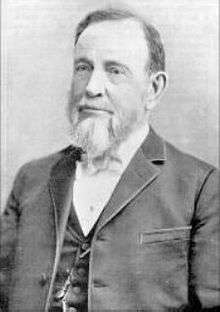Lewis A. Swift

Lewis A. Swift (February 29, 1820 – January 5, 1913 [1]) was an American astronomer.[2]
Discoveries
Swift discovered or co-discovered a number of comets, including periodic comets 11P/Tempel-Swift-LINEAR, 64P/Swift-Gehrels, and 109P/Swift-Tuttle (parent body of the Perseids meteor shower). He also discovered comets C/1877 G2, C/1878 N1, C/1879 M1, C/1881 J1, C/1881 W1, C/1892 E1, D/1895 Q1 (a.k.a. D/Swift, whose debris stream Mariner 4 probably encountered on September 15, 1967[3]), C/1896 G1 and C/1899 E1, and co-discovered C/1883 D1 (Brooks-Swift). Note, however, comet 54P/de Vico-Swift-NEAT was discovered by his son Edward D. Swift rather than by him.
He discovered his last comet at the age of 79. He was one of the few people to see Comet Halley at two of its appearances, 76 years apart (see also: External Link).
In 1878 he believed he had observed two Vulcan-type planets (planets within the orbit of Mercury), but he was mistaken.
Apart from comets, he also discovered hundreds of nebulae. One of them is IC 289.
Life
According to Swift, he first became interested in astronomy as young boy after observing the Great Comet of 1843 while on his way to school in Clarkson, New York. His teacher initially dismissed his observation, but three days later the 'discovery' of the comet was announced.[4]
Swift conducted his early observations in Rochester, NY, 'lain out in the snow' in an alley on Ambrose Street or on the roof of Duffy's Cider Mill. Later he gained a patron in the Rochester patent medicine businessman Hulbert Harrington Warner, who financed the building of an observatory for Swift. A fund of $13,000 was raised to purchase a 16 inch telescope for Swift.[2][4]
Warner went bankrupt in the Panic of 1893, which ended his financial support, and Swift then went to California to become director of Mount Lowe Observatory, taking the 16 inch telescope with him.[2]
He was married twice, first to Lucretia Hunt in 1850 and then to Carrie D. Topping in 1864. Edward D. Swift was his son by the latter wife.
Honors
Swift was awarded the degree of Ph. D. from the University of Rochester.[4]
Swift received more medals than any other astronomer of his time including three made of gold from the Austrian Academy of Sciences in Vienna,[5] four made of bronze from the Astronomical Society of the Pacific, and the Laplace Medal from the French Astronomical Society. In 1897 he was the first person awarded the Jackson-Gwilt Medal of the Royal Astronomical Society.[4]
The asteroid 5035 Swift is named in his honour, as is the lunar crater Swift.
Footnotes
- ↑ "Obituary Notes of Astronomers". www.astro.uni-bonn.de. Retrieved 2008-06-08.
- 1 2 3 Wlasuk, Peter T. (1996). "`So Much for Fame!': The Story of Lewis Swift". Quarterly Journal of the Royal Astronomical Society. Royal Astronomical Society. 37 (4): 683–707. Bibcode:1996QJRAS..37..683W. Retrieved 8 June 2016.
- ↑ NASA - Meteor Mystery, Solved? at science.nasa.gov
- 1 2 3 4 "Prof. Lewis Swift" (PDF). New York Times. Feb 2, 1902. Retrieved 2009-07-09.
- ↑ "English Mechanic and World of Science, Volume 70". Google Books. Retrieved 15 May 2015.
External links
- Works by or about Lewis A. Swift at Internet Archive
- The Story of Lewis Swift
- Lewis Swift (Photos)
- L. Swift @ Astrophysics Data System